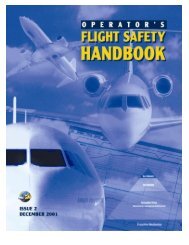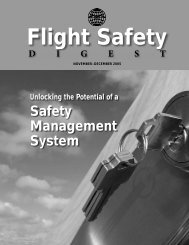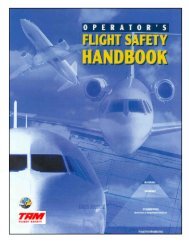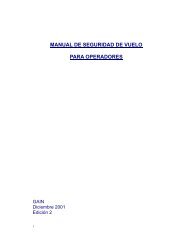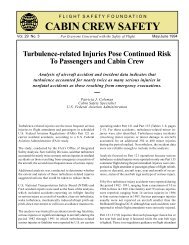Download PDF [10.9 MB] - Flight Safety Foundation
Download PDF [10.9 MB] - Flight Safety Foundation
Download PDF [10.9 MB] - Flight Safety Foundation
You also want an ePaper? Increase the reach of your titles
YUMPU automatically turns print PDFs into web optimized ePapers that Google loves.
‘Hazardous Proximity’<br />
An airliner on go-around and a business jet on departure<br />
came close together in an airport hot spot.<br />
BY MARK LACAGNINA<br />
FLIGHTSAFETY.ORG | AEROSAFETYWORLD | MAY 2013<br />
ONRECORD<br />
The following information provides an awareness of problems that might be avoided in the future. The information<br />
is based on final reports by official investigative authorities on aircraft accidents and incidents.<br />
JETS<br />
Late Go-Around Cited<br />
Airbus A320, Bombardier Learjet 60. No damage. No injuries.<br />
The absence of air traffic control (ATC)<br />
procedures ensuring separation between<br />
aircraft going around from one runway<br />
and entering the flight path of aircraft departing<br />
from a different runway contributed to an<br />
incident that placed the A320 and the Learjet in<br />
“hazardous proximity” at Las Vegas McCarran<br />
International Airport in Nevada, said the U.S.<br />
National Transportation <strong>Safety</strong> Board (NTSB).<br />
“The closest proximity of the two aircraft<br />
was approximately 0.3 nm [0.6 km] laterally and<br />
100 ft [30 m] vertically,” said the NTSB’s final<br />
report on the near midair collision, which occurred<br />
at 1225 local time on April 26, 2012.<br />
The A320 was inbound to Las Vegas on a<br />
scheduled passenger flight from Boston, Massachusetts,<br />
and the Learjet, of Mexican registration,<br />
was departing from McCarran. The report did<br />
not specify the Learjet’s destination or how many<br />
people were aboard either of the two aircraft.<br />
Day visual meteorological conditions (VMC)<br />
prevailed, with winds from the south at 19 kt,<br />
gusting to 26 kt. McCarran has two sets of parallel<br />
runways. Aircraft operations on Runways 25L<br />
and 25R, located on the south side of the airport,<br />
were being coordinated by a controller at the “local<br />
control 1” (LC1) position; operations on Runways<br />
19L and 19R, on the west side of the field,<br />
were being coordinated by a different controller<br />
at the “local control 2” (LC2) position.<br />
The A320 crew was conducting a visual<br />
approach to Runway 25L and had been cleared<br />
to land by the LC1 controller. Shortly thereafter,<br />
the Learjet crew was cleared for takeoff from<br />
Runway 19L by the LC2 controller.<br />
The departure thresholds of the runways are<br />
about 1,600 ft (488 m) apart. “The two runways<br />
do not physically intersect,” the report said.<br />
“However, the flight paths of the runways intersect<br />
approximately 0.32 nautical miles [0.59 km]<br />
past the departure end of Runway 19L.” Runway<br />
25L is 10,526 ft (3,208 m) long, and Runway 19L<br />
is 9,775 ft (2,979 m) long.<br />
The A320 was about one-third of the way<br />
down Runway 25L when the crew reported that<br />
they were going around. The LC1 controller<br />
acknowledged, saying in part: “Roger, on the<br />
go, and traffic will be at your two o’clock and<br />
one mile, a Learjet.” The controller also shouted<br />
“go around,” a normal practice to alert the other<br />
controllers on duty in the tower cab that a goaround<br />
was in progress.<br />
| 53


![Download PDF [10.9 MB] - Flight Safety Foundation](https://img.yumpu.com/18550968/55/500x640/download-pdf-109-mb-flight-safety-foundation.jpg)

![Download this Issue [PDF 7 MB] - Flight Safety Foundation](https://img.yumpu.com/18859635/1/190x245/download-this-issue-pdf-7-mb-flight-safety-foundation.jpg?quality=85)
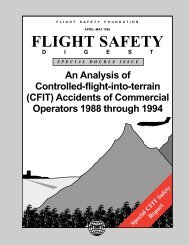
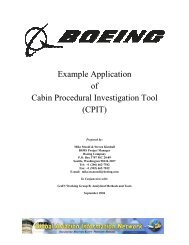
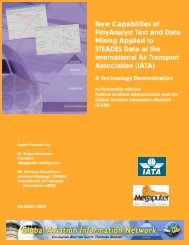
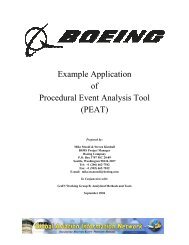
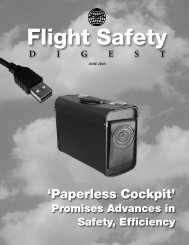
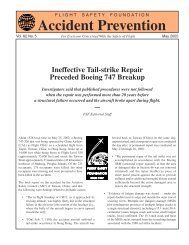
![Download [PDF 8 MB] - Flight Safety Foundation](https://img.yumpu.com/18859366/1/190x245/download-pdf-8-mb-flight-safety-foundation.jpg?quality=85)
